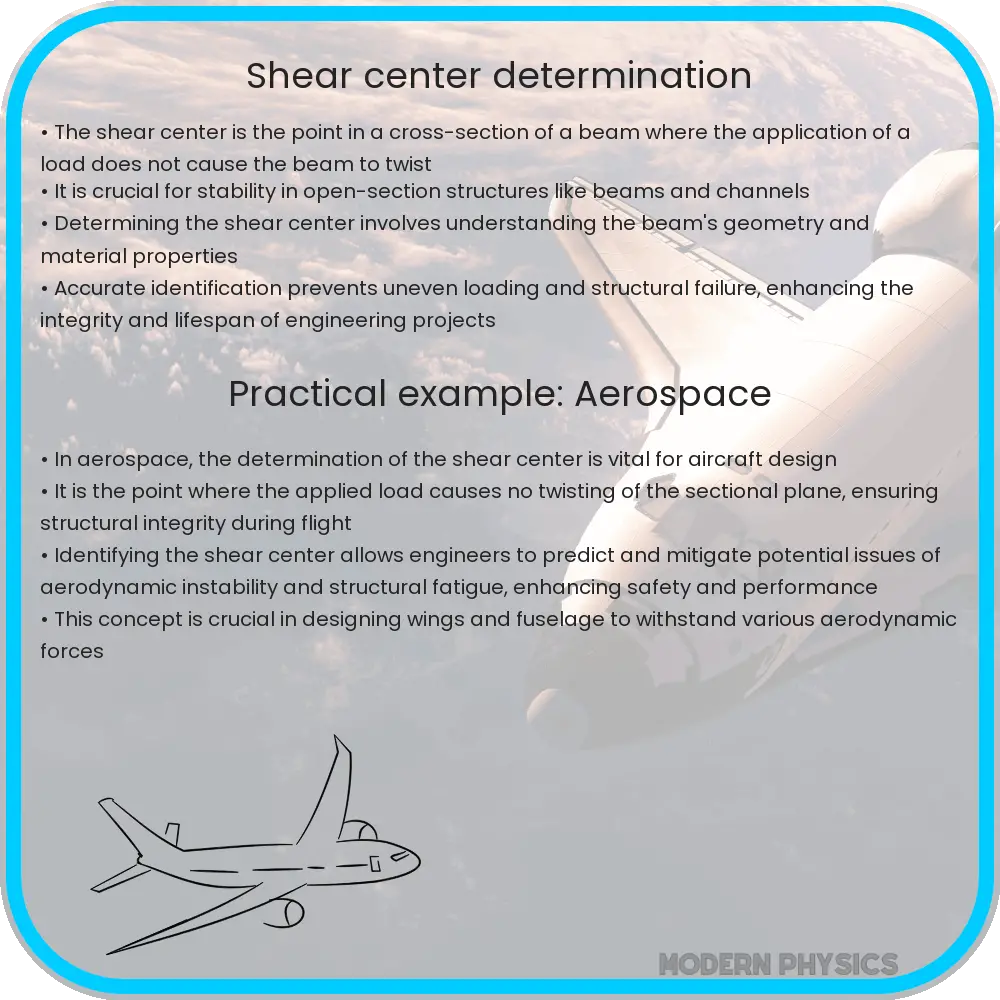Explore the importance of shear center determination in structural engineering, covering methods, challenges, and case studies for stability.

Understanding the Shear Center: An Essential Concept in Structural Engineering
The concept of the shear center is pivotal in structural engineering, particularly in the design and analysis of beams and other structural members subject to bending and shear loads. This article delves into the fundamentals of shear center determination, its importance in ensuring the structural stability, and the various methods used to calculate it accurately.
What is the Shear Center?
The shear center is a critical point in the cross-section of a beam or structural member. It represents the location at which a load can be applied to produce bending without causing the beam to twist. This point is crucial for asymmetrical cross-sections, such as I-beams, where the centroid and shear center do not coincide. The correct identification of the shear center ensures the stability of the structure by preventing torsional rotations and warping under load.
Importance in Structural Stability
Stability in structural components is paramount, and the shear center plays a key role in maintaining this stability. When loads are applied at the shear center, it minimizes the risk of unexpected torsional movements and vibrations, which are critical for the longevity and safety of the structure. Incorrect determination of the shear center can lead to structural inefficiencies and potential failure.
Methods for Determining the Shear Center
There are several methods for determining the shear center of a given cross-section:
- Experimental Methods: These involve physical testing of beam models to observe the torsional behavior under different loading conditions. While accurate, these methods can be time-consuming and expensive.
- Analytical Methods: These methods use mathematical equations and principles of mechanics. For simple shapes, the formulas are straightforward, but they become complex for irregular cross-sections.
- Numerical Methods: Computational tools like Finite Element Analysis (FEA) are employed for complex structures. These methods provide high accuracy but require computational resources and expertise in software handling.
Each method has its advantages and limitations, and the choice depends on the complexity of the structure, available resources, and the required level of accuracy.
Accuracy in Shear Center Determination
Accurate determination of the shear center is crucial for structural integrity. The level of accuracy required depends on the complexity and importance of the structure. For critical structures like bridges and high-rise buildings, very high accuracy is essential, while for less critical structures, a reasonable level of accuracy might be sufficient. Engineers must balance the need for accuracy with the available resources and the nature of the project.
Challenges and Solutions in Shear Center Determination
Identifying the shear center in complex structures presents unique challenges. In asymmetrical or non-uniform cross-sections, determining the exact point requires careful analysis. Variations in material properties and construction inaccuracies can also affect the shear center location. Engineers often use a combination of methods to enhance accuracy and validate results. Simulation software has become an increasingly popular tool, offering detailed insights that traditional methods might miss.
Case Studies and Practical Applications
Real-world applications highlight the importance of accurate shear center determination. In bridge construction, for example, ensuring that loads are correctly distributed to prevent torsional instability is crucial. Similarly, in the design of aircraft wings, precise knowledge of the shear center helps in maintaining aerodynamic stability. Case studies from these fields often serve as valuable learning tools for engineers, demonstrating the practical implications of theoretical concepts.
Advancements in Shear Center Analysis
Technological advancements have significantly impacted the field of structural engineering. Modern software not only allows for more accurate calculations but also provides visualizations that help in understanding complex behaviors. Research continues to develop more efficient algorithms and methods for shear center determination, particularly for unconventional and innovative materials and designs.
Conclusion
The determination of the shear center is a fundamental aspect of structural engineering that plays a vital role in ensuring the stability and safety of various structures. While the process can be challenging, especially for complex shapes and materials, the combination of experimental, analytical, and numerical methods provides a comprehensive approach to accurately identifying this crucial point. Ongoing advancements in technology and engineering practices continue to enhance our ability to predict and manage the effects of shear forces, ensuring that structures not only stand the test of time but also meet the increasing demands of modern design and construction. In the end, the precise determination of the shear center is not just a theoretical exercise but a practical necessity, underpinning the reliability and durability of our built environment.
